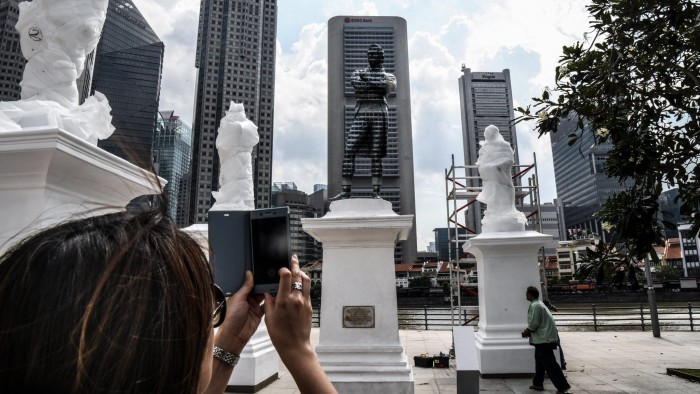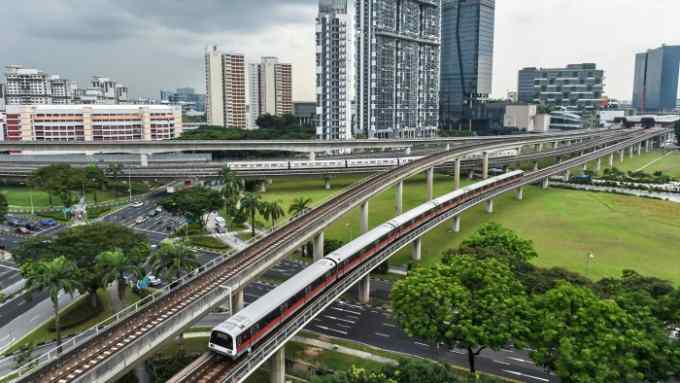Trade triumph and geopolitics mark Singapore’s 200th anniversary

Roula Khalaf, Editor of the FT, selects her favourite stories in this weekly newsletter.
At an exhibition commemorating Stamford Raffles’ 1819 arrival in Singapore, a question is plastered on a wall: “Which DNA trait do you think is most important to Singapore?” The most popular answer: “Self-determination.”
Two centuries after the landing that resulted in the founding of modern Singapore, the island is one of the few colonial port cities to have withstood the test of time. But as a tiny island nation of just 700 sq km and 5.6m people, Singapore has lacked the scale that has fuelled many of its economic peers.
Commercially, that has meant opening up to global trade flows, leading to Singapore’s services and merchandise trade volumes reaching three times gross domestic product in 2018 — one of the world’s highest ratios.
Geopolitically, the country has avoided picking sides and maintains good relations with much of the world — a rare diplomatic achievement.
But as tensions between the US and China threaten to upend global trade flows, heightened pressure from the two superpowers towards smaller nations has tested Singapore’s resolve to remain unaligned.
“We are seeing a reduction of strategic autonomous space for Singapore policymakers to make our own independent decisions on certain important issues,” says Ong Keng Yong, a Singaporean ambassador at large and executive deputy chairman of Nanyang Technological University’s S Rajaratnam School of International Studies.
Both China and the US are attempting to rally “as many friends as they can” to back their own points of view, he adds.
Honouring a nation’s colonial past with celebratory events, an exhibition and a special S$20 note might seem odd. But Tan Tai Yong, president of the Yale-National University of Singapore College, says Singapore is not “trying to glorify [its] colonial past but to mark a pivotal event in [its] history”. “At that point Singapore turned away from the region and became a more global part of the British empire.”
While the British exploited the island for their own economic interests, turning Singapore into a free port without duties or taxes set it on a course to become one of the world’s most advanced maritime economies. Raffles’ arrival “changed the destiny of the region”, the bicentennial exhibition states.
The commemoration is consistent with what Tim Harper, professor of south-east Asian history at the University of Cambridge, has described as postcolonial government efforts aimed at creating “a national community bounded by a common culture and a sense of place, and bonded by individual allegiance”.
Honouring the arrival of the British also helps a multicultural country celebrate the migrant communities who flocked to Singapore throughout the 19th century and shaped today’s society.
Singapore’s sense of itself as a self-determining nation that punches above its weight peaked in 2018 when it hosted the summit between US president Donald Trump and North Korean leader Kim Jong Un. Despite the hosts footing the summit’s S$20m ($14.7m) bill, the event largely stirred national pride as the city’s global visibility skyrocketed.
“When you participate internationally, people know that you carry a bit more weight,” Lee Hsien Loong, Singapore’s prime minister, said last year.
Under Lee Kuan Yew, Singapore’s first prime minister (1959-1990), the country acted as an intermediary between Washington — which at the time struggled to understand Beijing — and China, which had not found a voice on the global stage.
Decades later, Mr Lee’s son is in power and handling trickier relations with China and the US. At the 2019 Shangri-La Dialogue, an annual Asia-Pacific security forum, Lee Hsien Loong called on the world’s superpowers to not demand partiality.
“Unfortunately, when the lines start to get drawn everybody asks ‘are you my friend or not my friend?’ And that makes it difficult for small countries,” Mr Lee said. “To actively avoid taking sides also requires actively not being pressured to take sides.”
Both China and the US are critical commercial partners for the city state. China is Singapore’s largest trading partner as well as the top recipient of the city state’s outward direct investment, while the US is the biggest source of foreign direct investment for the island nation.
Multinationals from both countries have picked Singapore to house their regional headquarters and to raise capital for expansion across south-east Asia.
More broadly, global trade underpins the prosperity of Singapore, which is the world’s second-largest port worldwide by volume after Shanghai.
“We have to depend on the world as our hinterland, which means that trade must be our lifeline,” says Chan Chun Sing, Singapore’s minister for trade and industry, especially given that the country imports “pretty much everything we use here.”
Singapore has ratified 24 trade agreements and economic partnerships that cover more than 90 per cent of exports, saving Singapore money while giving exporters access to more markets, says Mr Chan.
But Singapore’s place in global trade could be jeopardised by events such as the US-China dispute or Brexit, causing “a sharp drop in confidence toward investment and job creation”, says Mr Chan. “That is a volume problem, not a shift of [trade] flows problem” that Singapore would be prepared for, he adds, citing the Port of Singapore Authority (PSA) as an example.
Should the US-China dispute cause a shift in trade away from Singapore, the city state could still benefit from those flows via institutions such as the PSA, which has operations in ports across the globe, including Antwerp, Gdansk and Chongqing. “Tomorrow trade flows can shift again and Singapore must be where the action is, rather than waiting for the action to come here,” says Mr Chan.
Yet a downturn in the electronics sector caused by excess supply — which might worsen after Washington blacklisted Chinese telecoms group Huawei — could hurt the city state.
“That’s where you don’t want to be a small, tech-heavy, very open economy like Singapore,” says Robert Carnell, chief economist for Asia-Pacific at ING, the Dutch bank. “You then have to fall back on all sorts of government policy measures to keep the domestic economy ticking along.”
He notes, however, that the country’s fiscal position remains “absurdly strong”, with a pool of overseas assets that can support the budget if necessary.
On the security front, Singapore has maintained tight relations with the US — which date to the 1960s — in spite of China’s growing regional influence.
The city state last month said it would renew a memorandum of understanding that gives Washington access to Singapore’s air and naval bases. It has also ordered several F-35 combat jets, manufactured by US group Lockheed Martin, to replace its ageing F-16s.
At the same time, Singapore hopes to sign an “enhanced agreement” with Beijing involving more military exercises, says Ng Eng Hen, Singapore’s defence minister.
With the two largest economies in the world showing no sign of reconciliation and their trade dispute threatening to kick off a tech war, self-determination could shape Singapore’s DNA for centuries to come.

Comments